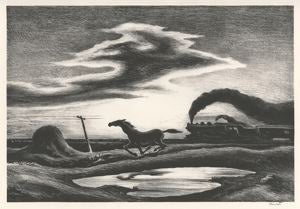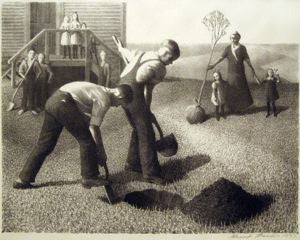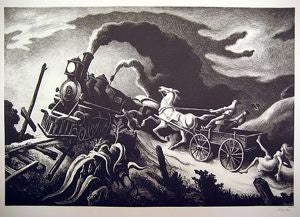An exhibition of fine prints for the opening of the fall term, 1985.
Introduction:
In Rural America Revisited, the University’s fourth annual exhibition of American Fine Prints of the Twentieth Century, Georgetown offers its students, faculty and friends a unique opportunity to examine first-hand one third of the total graphic oeuvre of the three giants of American realism of a half century ago—Thomas Hart Benton, John Steuart Curry, and Grant Wood.
Although each of these artists developed his own unrelated artistic style and technique, the Eastern art establishment of the 1930’s denominated their work as “Regionalist.” And America’s depression-weary public liked what they saw—an escape into Regionalism’s nostalgic and often idealistic recreation of a rural America, presented for the most part devoid of the political and social turmoils of the day and the ravaging effects of the great depression.
Confronted by the collapse of the country’s industrial, commercial, and financial foundations of the 1920’s, many Americans found solace, inspiration, and renewed hope in looking back to the perceived roots of their nation’s democratic spirit and dynamism in the rural setting of America’s middle west. With Time magazine’s enthusiastic review of December 24, 1934, Regionalism’s vogue was assured.
But its championed practitioners, Benton, Curry, and Wood, felt a certain unease with the term, questioning both the precision of its meaning and its validity as an emerging category into which the scholars and critics were attempting to place their art.
As Benton expressed it in his University of Kansas City Review article of 1951 entitled “American Regionalism: A Personal History of the Movement,”
Wood, Curry, and I thought of ourselves simply as American or Americanist painters, sectional at one moment, national and historical at others. If we dealt largely with “agrarian” subjects, it was because these were significant parts of our total American experience….
However, the milk was spilt. Regionalists we became and the victims thereby of a lot of odd and inaccurate definitions which the word suggested. “Regional” and “provincial” were made synonymous for our cases….
Otherwise put, we were bent on returning painting to its historic representational purpose and, further, in the interests of an American art, to making it represent matter drawn from American life and meaningful to those living that life.
How well Benton, Curry and Wood succeeded is for our viewers to ponder. Although Regionalism as a movement has been long since gone, its accomplishments are enshrined in collections such as Georgetown’s from which forty-eight of this exhibition’s fifty prints were culled, and in the art history texts of our classrooms.
Georgetown takes special pleasure in presenting this exhibition of a rural America of a half century ago. For indeed, one of its artists, the young Tom Benton, a congressman’s son from Missouri, received his first training in art within sight of the University’s Healy Tower at our neighboring institution, Western High School in Georgetown, now the home of Washington’s Duke Ellington School of the Arts.
Catalogue of the Exhibition
The prints in this list, all lithographs, are arranged as they appeared in the six wall cases and four table cases. As one moved along the wall, the prints told a “story without words” of a family’s imaginary return to the rural America of a half century ago with the three great regionalist printmakers serving as hosts. The prints in the table cases add a few sidelights of interest in things seen and experienced during the visit.
Welcome Back! –Thomas Hart Benton
Frisky Day, 1939
Fath 30
The Race, 1942
Fath 56
The Farmer’s Daughter, 1944
Fath 62
Down the River, 1939
Fath 33
The Music Lesson, 1943
Fath 60
I Got a Gal on Sourwood Mountain, 1938
Fath 19
Looking Over the Farm – John Steuart Curry
Valley of the Wisconsin, 1945
Cole 45
Our Good Earth, 1942
Cole 36
Summer Afternoon, 1940
Cole 35
Sanctuary, 1944
Cole 38
Prize Stallions, 1938
Cole 31
Stallion and Jack Fighting, 1943
Cole 37
Exchanging News – Grant Wood
Tree Planting Group, 1937
Cole 1
Honorary Degree, 1938
Cole 4
Midnight Alarm, 1939
Cole 12
Shrine Quartet, 1939
Cole 11
Sultry Night, 1939
Cole 6
Family Doctor, 1940
Cole 18
December Afternoon, 1940
Cole 16
A Hand With the Chores – Thomas Hart Benton
Cradling Wheat, 1939
Fath 27
Threshing, 1941
Fath 48
Island Hay, 1945
Fath 68
Loading Corn, 1945
Fath 65
The Corral, 1948
Fath 71
Nebraska Evening, 1941
Fath 45
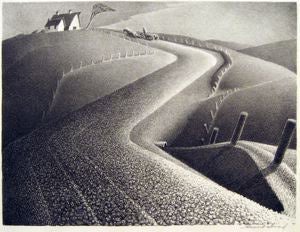
The Fertile Land – Grant Wood
March, 1939
Cole 14
In the Spring, 1938
Cole 13
July Fifteenth, 1938
Cole 5
Fertility, 1939
Cole 15
Seed Time and Harvest, 1937
Cole 2
January, 1938
Cole 3
Farewell – Thomas Hart Benton
Spring Tryout, 1943
Fath 61
Goin’ Home, 1937
Fath 14
Gateside Conversation, 1946
Fath 69
Lonesome Road, 1938
Fath 18
The Boy, 1948
Fath 72
Edge of Town, 1938
Fath 22
Fruits of the Field – Grant Wood
Fruits, 1939
Cole 7
Vegetables, 1939
Cole 8
Tame Flowers, 1939
Cole 9
Wild Flowers, 1939
Cole 10
Cotton Culture – Thomas Hart Benton
Planting, 1939
Fath 28
Hoeing Cotton, ca. 1938
Fath 93 (lent by Sylvan Cole, Jr.)
Back From the Fields, 1945
Fath 66
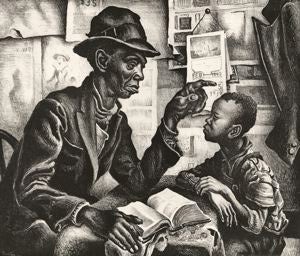
Rural Readers – Thomas Hart Benton
Old Man Reading, 1941
Fath 44
Letter from Overseas, 1943
Fath 59
Instruction, 1940
Fath 41
The Trains That Come – Thomas Hart Benton
Slow Train through Arkansas, 1941
Fath 46
Wreck of the 0l’ 97, 1944
Fath 63
Morning Train, 1943
Fath 58

